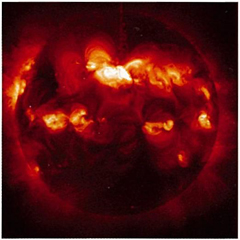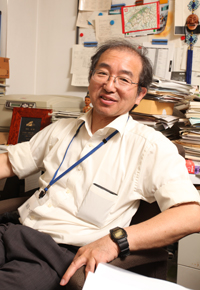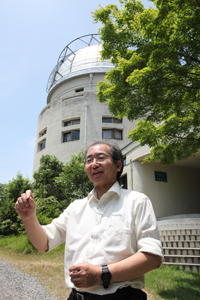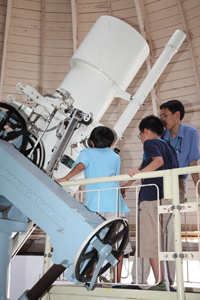
In the summer of 2010, the successful return of the Hayabusa spacecraft to Earth with a surface rock sample from asteroid Itokawa excited the nation. The nation was not only moved by the stirring drama of how it overcame apparently desperate situations, but also fascinated by the heightened expectation of finding in the microscopic particles invisible to the human eye a key to discerning the mystery regarding the birth of the sun and the solar system. "Where did we (living organisms) come from?" is a universal question that Professor Kazunari Shibata from the Graduate School of Science (director of Kwasan and Hida Observatories) has been grappling with as he leads the world's research on the sun. We interviewed him about the present situation within the field of cosmology.
"The sun has flares more wildly than we had thought."

(Photo) The sun observed by soft X-rays. The corona, which can be seen, has a loop structure, while the areas around the poles are where the magnetic force lines open toward interplanetary space (corona holes), which appears dark. March 28, 2001 (Photo courtesy of the Institute of Space and Astronautical Science, JAXA )
According to Professor Shibata, research on the sun has seen great advances since the late 1990s, and new findings are obtained on an almost monthly and daily basis. This is due to the improved precision of visual light observation and optical radiation observation using diverse wavelengths such as ultraviolet, X-ray and H-alpha, and the stock of observation data from solar observation satellites, including Japan's Hinode spacecraft. An analysis of these observation data has unveiled a picture of the sun quite different from our conventional notion.
While it has been known for a long time that sunspots increase in number when the star is highly active, the sun has been considered for the most part to be a relatively moderate star. However, these observation technologies have enabled us to go beyond the sun's surface (the photosphere), which we had previously been able to view, and see the upper chromosphere and the corona further above (super-high temperature plasma at about 1 million degrees Celsius), which reveal that the sun is wilder than we had thought with repeating eruptions (flares) on a daily basis (see photo).
"Big flares can have a great impact on the earth. That's why we urgently need space weather forecasting."

Solar flares emit high-energy radiation and massive plasma clouds toward the earth. While the effects of a small flare are largely prevented by the geomagnetism and the atmosphere, causing very little impact on the earth's surface, larger ones have an impact that can reach the earth's surface and cause magnetic storms, disturbing radio communications or affecting social infrastructures such as power stations. In 1989, for example, a big flare interrupted the power supply to several million houses in Canada. The impact is tremendous in space, where there is nothing to act as a shield. In 2003, a flare caused problems with observation satellites, and astronauts were temporarily evacuated from a space station.
In the future, as space development progresses and activities in outer space increase, the possibilities of flare-caused damage to equipment and astronauts will increase as well. In addition, now we know that the sun's activities are a lot more violent than we had envisioned, which means we cannot rule out the possibility of these great flares causing tremendous damage to the earth's surface. As a result, it is essential to develop a space weather forecasting system that forecasts changes in the space environment around the earth, which is associated with the sun's activities. Its goal is to detect immediately the occurrence of a flare, its scale, and the level of impact as well as to predict the occurrence of a flare. Professor Shibata has played a leading role in international research on this space weather forecasting system. In fact, in 1994, he predicted a flare by analyzing data from an observation satellite and issued a warning by email to the world. When a magnetic storm actually took place two days later, power companies averted hundreds of millions of yen in damage thanks to measures that had been taken in time. The U.S. government and NASA were incredibly grateful to Professor Shibata.
"As we study the sun, we learn a law regarding the evolution of space."

To explain the mechanism of flares, a "magnetic reconnection" model was developed from the 1960s to the 1970s, based on physical phenomena in which adjacent magnetic lines in opposite directions are reconnected at a contact point, causing a burst of gas jet at a breakneck speed by means of the "slingshot effect." The hypothesis has been debated for years, but now is mostly accepted. Studying the magnetic reconnection further, the latest observation by Hinode revealed that small flares (nano-flares) occur here and there in the sun's chromosphere. Recent observations have revealed that similar flares also occur on other stars in space. Hence, Professor Shibata proposes an idea called "ubiquitous reconnection," predicting that reconnections occur on all astronomical objects, and eruptions (nano-flares) and jet bursts induced by them constitute the universal nature of space. This idea is expected to be able to provide a single model to explain the mechanism behind the heating of the corona to super-high temperatures on the sun (or on all stars in space) and eventually open a perspective for a universal law regarding the evolution of space.
"Pursuing research on life in space: synergetic studies for space"

Professor Shibata further gave us an interesting insight into the relation between the study of the sun and the evolution of life on Earth. It is well known that solar light and heat played a critical role in the birth of life, but he further argues that solar flares may have significantly affected evolutionary processes. On Earth, about five cases of mass extinctions of species have taken place in the past 500 million years. Out of these, the extinction of dinosaurs is attributed to the collision of a huge meteorite, but no particular cause has been identified for other large-scale extinctions.
Professor Shibata believes that mass extinctions have been caused by an overwhelming energy of radiation and magnetic flux from a mega flare on the sun, since the possibility of a mega flare of such a scale cannot be ruled out in the long run. Furthermore, it has been accepted that normal flares cause no impact on the earth's surface, as we mentioned earlier. However, studies in fact have been presented at international conferences revealing findings such as traffic accidents that are more frequent, or patients in hospitals whose conditions tend to get worse, when there are many solar flares, as well as geomagnetic fluctuations and blood pressure fluctuations which are correlated. In addition, at Kyoto University there is a professor who studies the relation between geomagnetism and suicide. It may be possible that a flare of a once-in-a-ten-thousand-year scale affected the evolution of life.
Thus, pursuing the study of the sun (and the relation between the sun and the earth) leads us ultimately to pursue the question of what the conditions are for survival of life in space. From such perspectives, the Unit of Synergetic Studies for Space (Kyoto University) currently headed by Professor Shibata is ready to take up the grand challenge toward such a pursuit, which will encompass not only space physics and space engineering but also space medicine and space biology as well as human sciences such as space industry and economy or civilization studies.
"Currently, I'm thinking hard about how I can predict the future. It will be great if, in thinking about the future, we can come up with a new idea that nobody has ever thought of before… Here at Kyoto University, you find many researchers dreaming about such crazy things. As you can see from Dr. Kinji Imanishi or Dr. Hideki Yukawa, one of Kyoto University's strengths lies in its exploration of new fields because that kind of excitement exists all around the university."
Maybe it is Professor Shibata's head that is always full of "eruptions."
Reported on July 25, 2010
Topic: About Kwasan and Hida Observatories, Graduate School of Science, Kyoto University

Kyoto University currently has two astronomical observatories: Kwasan Observatory in Yamashina, Kyoto and Hida Observatory in Takayama, Gifu. Kwasan Observatory, which was founded in 1929, is the second oldest university-managed observatory in Japan. Sometimes called a sacred place for Japanese amateur astronomers, it has been used mainly for the observation and research of the sun, while serving as a center of astronomical education activities for the general public. Today, observation meetings and other events are periodically held and organized by the NPO Kwasan Astro Network, which is comprised of the observatory's staff as key members.
In 1968, Hida Observatory was founded with the aim of succeeding Kwasan Observatory, as its surroundings had become brighter due to urban development. Equipped with one of the best Domeless Solar Telescopes (DST) in the world for solar spectrometry and a Solar Magnetic Activity Research Telescope (SMART), which has the world's highest performance in the observation of magnetic fields on the entire sun and H-alpha radiation, the observatory is the world's center of solar observation.
At the present time, the university is planning to build a 3.8 m optical infrared telescope in Okayama Prefecture using new technology through a joint project with the National Astronomical Observatory of Japan, Nagoya University and another institute .
Profile
Born in Osaka Prefecture in 1954, as a little child, Professor Kazunari Shibata was absorbed in such thoughts as "Why am I here?" This little boy--who thought, "I'd like to be a scholar, alone on a remote mountain, absorbed in research"--was strongly impressed by George Gamow's "Mr. Tompkins" series when he was in the first year of junior high school, and became fascinated by astronomy. Later, he chose to study at Kyoto University's Faculty of Science, attracted by its liberal atmosphere." As a big fan of Dr. Tadao Umesao, I was interested in anthropology, but I gave up the idea because I was so fussy about my food and afraid I wasn't made for exploration," he said. When he was in graduate school, with the ambition of winning the Nobel Prize by solving the greatest mystery of space physics, he began studying the eruptions occurring on the sun to solve the mystery of jets bursting from the center of the galaxy. "It turned out to be more effective than I had thought. I found explosive phenomena occurring in every part of space with mechanisms surprisingly similar to that on the sun," said Professor Shibata. In 2009, he received the NISTEP Award for achieving outstanding results in the science and technology field from the National Institute of Science and Technology Policy, MEXT, which officially recognized his contributions to the study of solar activity phenomena as fundamental research for space weather forecasting. His recent book, Taiyo no Kagaku ("The Science of the Sun") [NHK Books, published January 2010], which explains his research in plain words, won the Kodansha Science Publication Award.
- Kwasan and Hida Observatories, Kyoto University http://www.kwasan.kyoto-u.ac.jp/index_en.html
- Kazunari Shibata http://www.kwasan.kyoto-u.ac.jp/~shibata/

